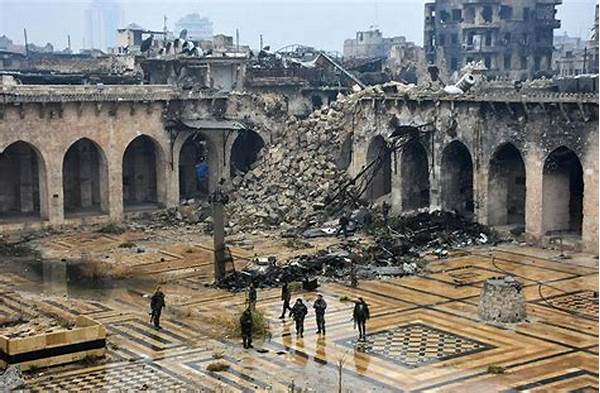Historical preservation in war zones is an imperative endeavor, aimed at safeguarding cultural heritage amidst the ravages of conflict. This delicate task involves a confluence of international cooperation, local efforts, and rigorous methodologies to ensure that the remnants of history are not obliterated by the tempest of war. These sites, symbols of a shared global history, serve as poignant reminders of our past, and their preservation fosters a continuous dialogue between history and modernity.
The Importance of Protecting Cultural Heritage
The protection of cultural heritage in war zones is vital to maintaining the socio-cultural fabric of affected areas. Historical preservation in war zones not only ensures the survival of tangible cultural properties but also preserves intangible traditions and stories tied to these sites. Protection efforts often involve collaboration between governments, international bodies, and local communities, each playing an integral role in maintaining a sense of identity and history during and after conflicts. Additionally, the preservation of such sites acts as a testament to human resilience and adaptability, demonstrating an unwavering commitment to heritage even in the most challenging circumstances.
The endeavors toward historical preservation in war zones often utilize various strategies, including documentation, legal frameworks, and physical protection measures. These measures are crucial in combatting intentional destruction and the collateral damage of armed conflicts. Through meticulous planning and execution, such strategies aim to mitigate the adverse effects of war on cultural sites and ensure their longevity for future generations.
Strategies for Effective Preservation
1. International Collaboration: Historical preservation in war zones requires international cooperation, bringing together expertise, funding, and political support to safeguard heritage.
2. Local Engagement: Communities play a crucial role, with their intimate knowledge of cultural sites aiding in effective preservation efforts.
3. Technology Utilization: Advanced technologies, such as 3D modeling and AI, support the accurate documentation and preservation of sites pre-, during, and post-conflict.
4. Legal Frameworks: Robust legal frameworks are essential, providing the necessary guidelines and sanctions to protect cultural heritage in tumultuous regions.
5. Education and Awareness: Spreading awareness about the importance of historical preservation in war zones can galvanize global support and prevent illicit activities.
Challenges in Preserving Cultural Heritage
In the intricate landscape of global conflicts, historical preservation in war zones confronts significant challenges. The volatility and unpredictability of war often lead to immediate threats to cultural sites. These threats are further compounded by looting, neglect, and inadequate local resources. The international community’s response, while crucial, is frequently hindered by complex political landscapes, resource constraints, and logistical hurdles unique to war zones.
Despite these challenges, resilient strategies and innovative solutions have emerged. Organizations dedicated to preservation work incessantly to implement proactive measures. This includes pre-emptive documentation of sites, fostering local stewardship to maintain and protect heritage, and advocating for international conventions to hold accountable those who perpetuate cultural destruction. The chronicles of history emphasize the necessity of these endeavors, ensuring cultural continuity and providing solace and identity to affected populations.
Global Initiatives Supporting Preservation
Numerous global initiatives serve as the backbone for historical preservation in war zones. Organizations such as UNESCO, the International Committee of the Blue Shield, and others are pivotal in spearheading efforts to safeguard cultural heritage. They provide a framework through which countries can rally to protect and preserve vital historical sites. These initiatives facilitate the sharing of best practices, promote legal protections, and support educational programs aimed at building local and international capacity in preservation fields.
Efforts also focus on post-conflict recovery, where historical preservation in war zones becomes a key component of peacebuilding and reconciliation. The restoration of cultural heritage sites assists in healing communities, restoring identities, and fostering socio-economic development. The international community’s support in these endeavors reinforces the notion that preserving cultural heritage is a collective responsibility, transcending borders and cultural divides.
Technological Advancements in Preservation
The integration of technology has revolutionized historical preservation in war zones. Modern tools such as satellite imagery, digital archiving, and 3D reconstruction have enabled more efficient and precise preservation efforts. These technologies facilitate the remote monitoring of at-risk sites, allowing for timely interventions and assessments. Moreover, digital records serve as invaluable resources for education and research, preserving knowledge even if physical sites are compromised.
The application of technology in historical preservation in war zones exemplifies innovation in the face of adversity. These technologies not only ensure the protection of cultural heritage but also foster global engagement and raise awareness about the importance of preserving history for future generations. As technology continues to evolve, it promises further contributions to safeguarding our shared cultural legacy.
Community Initiatives and Local Impact
Local communities are indispensable to historical preservation in war zones. They are the stewards of cultural heritage, with intrinsic ties to historical sites that transcend mere physical structures. Empowering these communities through education, resources, and active involvement ensures the longevity and authenticity of preservation efforts. Local initiatives often provide grassroots solutions to the challenges posed by conflict.
Involving communities in historical preservation in war zones fosters a sense of ownership and pride. It instills a commitment to safeguarding their heritage against both the direct and indirect impacts of war. This community-centered approach not only benefits the preservation of cultural sites but also enhances the resilience and cohesion of affected populations, aiding in broader recovery and development efforts post-conflict.
Conclusion
In conclusion, historical preservation in war zones is a multifaceted endeavor that requires international cooperation, technological intervention, and robust local engagement. Despite formidable challenges, the concerted efforts of the global community, bolstered by cutting-edge technologies and comprehensive strategies, play an instrumental role in safeguarding our cultural heritage. These efforts ensure that even amidst the devastation of war, cultural legacies are preserved and continue to inspire and educate future generations.
The ongoing commitment to historical preservation in war zones highlights the universal significance of cultural heritage, offering hope and continuity amidst turmoil. As conflicts persist, the preservation of history becomes ever more critical, serving as a reminder of our shared past and a beacon guiding future reconciliation and peacebuilding initiatives.





